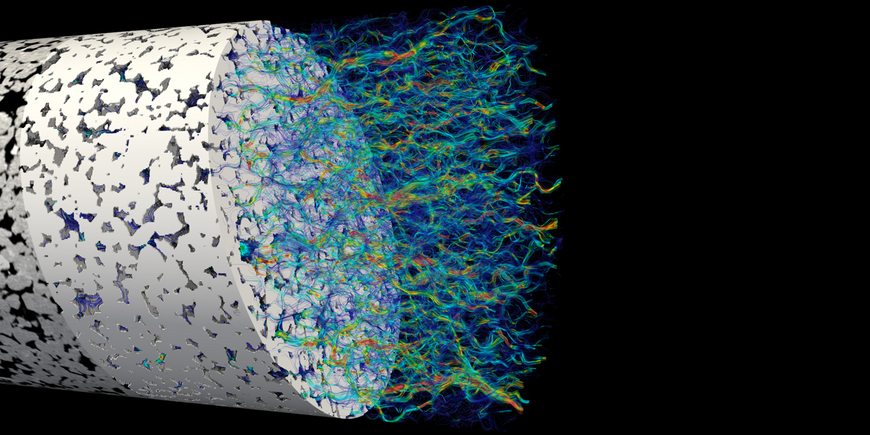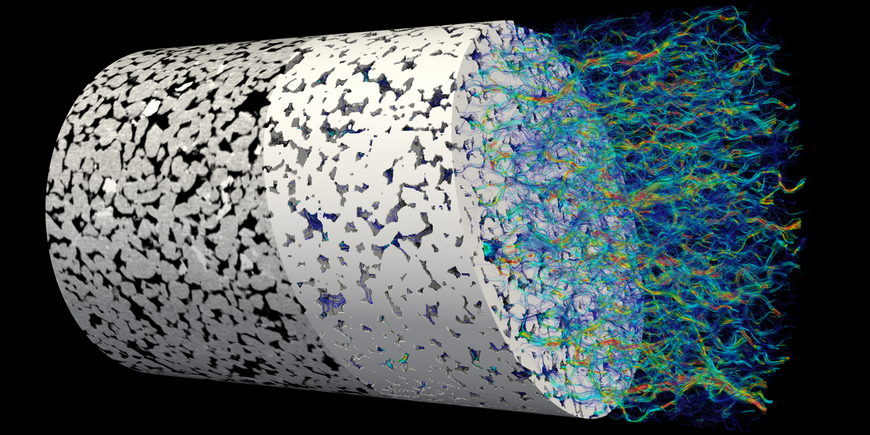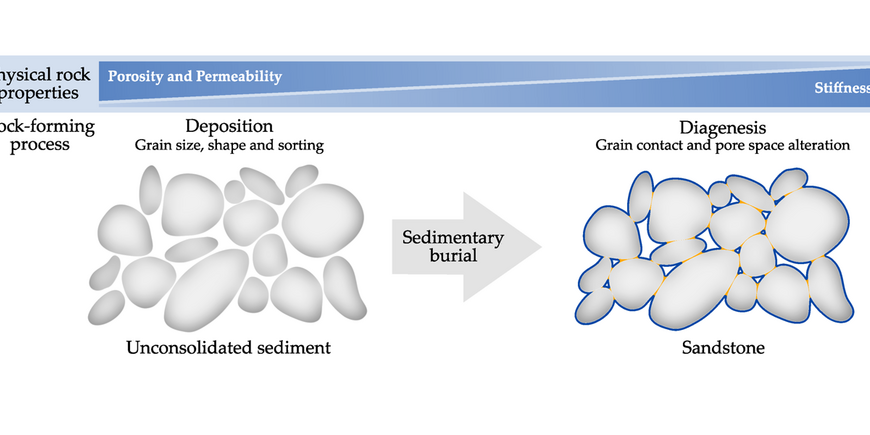For production of geothermal energy and underground storage of energy in the form of heat, compressed air or gas, a very good hydraulic permeability of the reservoir rocks is a basic requirement. In the case of sandstones, for example, the structure and distribution of sand grains and pores determine whether a formation can be used in a technically and economically efficient manner. With virtual rock cores, the properties of potential reservoirs can be investigated without costly field tests and time-consuming laboratory analyses. A team led by Maria Wetzel of the GFZ German Research Centre for Geosciences Potsdam has developed a new approach for "producing" such cores for three types of typical reservoir sandstones. It mimics the natural process of formation. For the first time, a variety of natural grain shapes can be modelled, resulting in a much more realistic model. The work was the cover story of the journal Minerals.
Advantages of digital rock physics
Digital rock physics is becoming an important tool for assessing the availability of geological resources and for using the geological subsurface in a sustainable and environmentally friendly way. Virtual rock cores are created on the basis of computer tomography images, which can be used to calculate the development of the mechanical and hydraulic properties of rocks and then scaled up to the entire reservoir. It depends on the interaction between grain and pore space and the fluids flowing through. For example, if minerals clog the pore space, this reduces the flow rate of gas or water. Ultimately, the permeability of the rock determines how efficiently and economically a reservoir can be used, for example to extract geothermal energy or to store heat, compressed air or gas.
In recent years, advances in imaging techniques and further increases in computing power have made it possible to simulate a wide range of physical processes, based on high-resolution digital 3D images of the pore space of rocks with several million elements. However, the quality of the predictions depends crucially on the quality of the models used.
New approach for modelling sandstone
Maria Wetzel and her colleagues Thomas Kempka and Michael Kühn, all from the GFZ and the University of Potsdam, have now presented a new approach with which they can reproduce typical reference rocks in digital models more precisely and closer to nature than before. These are three sandstones that occur for example in the North German Basin: Fontainebleau, Berea and Bentheim.
Simulation of rock formations
The starting point for their modelling are micro-computer tomography (CT) images of a sandstone, from which typical shapes and size distributions of the sand grains can be extracted. Then the researchers simulate the process of rock formation: First, sand grains are deposited as sediments under the influence of gravity and compact. When water is added, the so-called cementation begins: dissolved minerals carried by the water - abrasion of the grains themselves or external material - are deposited preferably at grain contacts and in pore throats, cementing the grains together.
The researchers applied three different processes and compared the results with micro-CT scans of real samples. In doing so, they looked at the granular properties, which are expressed, for example, in pore and pore-throat diameters, the hydraulic properties, which determine the permeability of the rock, and the elastic properties. "A combination of cementing grain contacts and uniform mineral growth gave a very good approximation," says Maria Wetzel, who has just completed her PhD on the subject.
Mapping realistic shapes and sizes
"What is new about our approach is that we take into account the diverse natural shapes, sorting and sizes of the sand grains. Therefore, we can now map the highly complex structures of the pore spaces notably well, as shown by the comparisons with the real rock cores. The more precisely we understand the processes on the pore scale, the better we are able to extrapolate their effects to the entire reservoir," Wetzel emphasises.
Michael Kühn, head of the Section Fluid Systems Modelling at the GFZ, adds: "With our method, we can overcome the general limitations of imaging methods. This concerns in particular the image quality, too low resolutions of the grain contacts of small pores as well as inaccuracies induced by the image processing." In addition, high-resolution micro-CT scanners are not yet widespread and the procedure is very time-consuming.
Virtual experiments based on the digital rock cores
The digital rock cores serve the researchers as a basis for further virtual experiments. They use them to investigate, for example, which effects the dissolution or the precipitation of mineral components of a fluid impose on the permeability of the rock. This is of particular importance for the exploration and sustainable use of the geological subsurface.
Due to a lack of alternatives, analytical methods have been used to date, but their significance is limited because they are based on idealised microstructures like round or elliptical grains. "With the help of our approach, the validity of reservoir models can be fundamentally improved because the uncertainties due to simplifications are reduced. Digital rock physics is thus a valuable addition to cost-intensive field tests and complex laboratory analyses," Maria Wetzel sums up.
Original study: Wetzel, M.; Kempka, T.; Kühn, M. Diagenetic Trends of Synthetic Reservoir Sandstone Properties Assessed by Digital Rock Physics. Minerals 2021, 11, 151. DOI: 10.3390/min11020151
Scientific contact:
Maria Wetzel
Section 3.4 Fluid Systems Modelling
Helmholtz Centre Potsdam GFZ
German Research Centre for Geosciences
Telegrafenberg
14473 Potsdam
Phone: +49 331 288-28669
Email: maria.wetzel@gfz-potsdam.de
Media contact:
Dr. Uta Deffke
Public and Media Relations
Helmholtz Centre Potsdam
GFZ German Research Centre for Geosciences
Telegrafenberg
14473 Potsdam
Phone: +49 331 288-1049
Email: uta.deffke@gfz-potsdam.de










![[Translate to English:] Torsten Sachs in front of a climate station on a field](/fileadmin/_processed_/3/9/csm__TorstenSachs_bearbeitet_GS_4a1365ef84.jpeg)

![[Translate to English:] left image flood at the Ahrtal: image from above, several houses are flooded; left image:: Heidi Kreibich;](/fileadmin/_processed_/4/4/csm_Bild2_9af0130e9f.png)



![[Translate to English:] Start der Vega Rakete](/fileadmin/_processed_/6/4/csm_20231201-kachel_Vega-VV23-launch_ESA-CNES-Arianespace_706716b68c.jpeg)









![[Translate to English:] Poster exhibition at the Brandenburg Hydrogen Day at the GFZ, some participants in the foreground](/fileadmin/_processed_/6/5/csm_Erster_Brandenburgischer_Wasserstofftag_GFZ_402fcec95e.jpeg)
![[Translate to English:] Group picture of the participants](/fileadmin/_processed_/9/4/csm_20231108_CAWa-Workshop-Tashkent_Gruppenbild_99ea779d8a.jpeg)

![[Translate to English:] [Translate to English:] Hörsaal](/fileadmin/_processed_/e/6/csm_H%C3%B6rsal_e21ac645fb.jpeg)


![[Translate to English:] The Delegations in the Historic Library on the Telegrafenberg. In the back there are from left to right, the Dutch Ambassador for Germany, Ronald van Roeden, the Dutch Minister for Education, Culture and Science, Robbert Dijkgraaf and the scientific director of the GFZ, Susanne Buiter.](/fileadmin/_processed_/d/b/csm_Kachel-2_9eba4b4212.jpeg)

